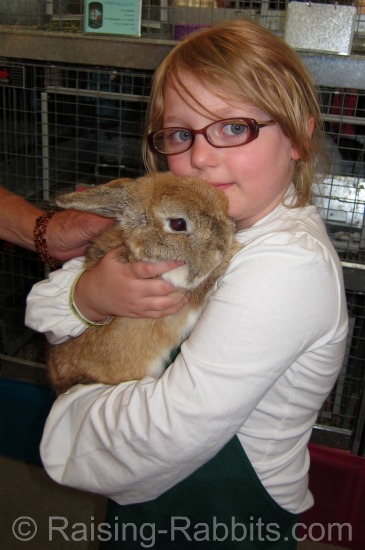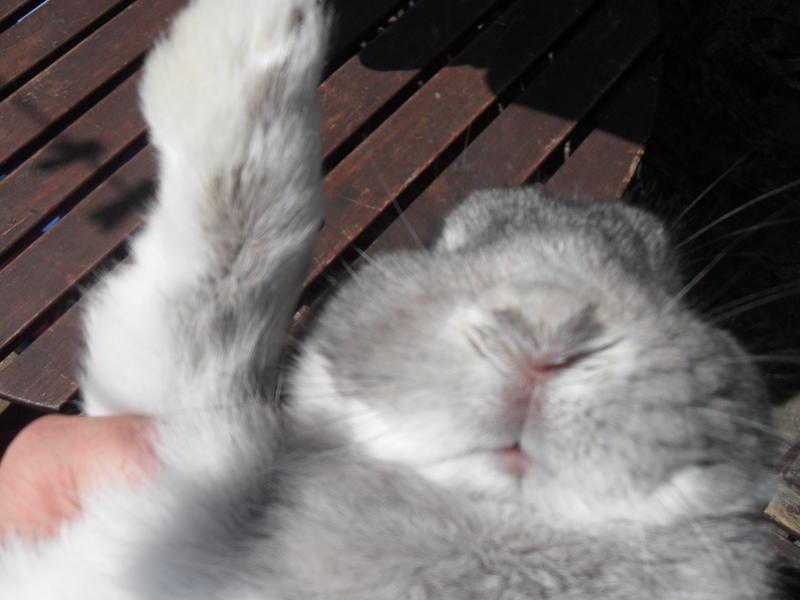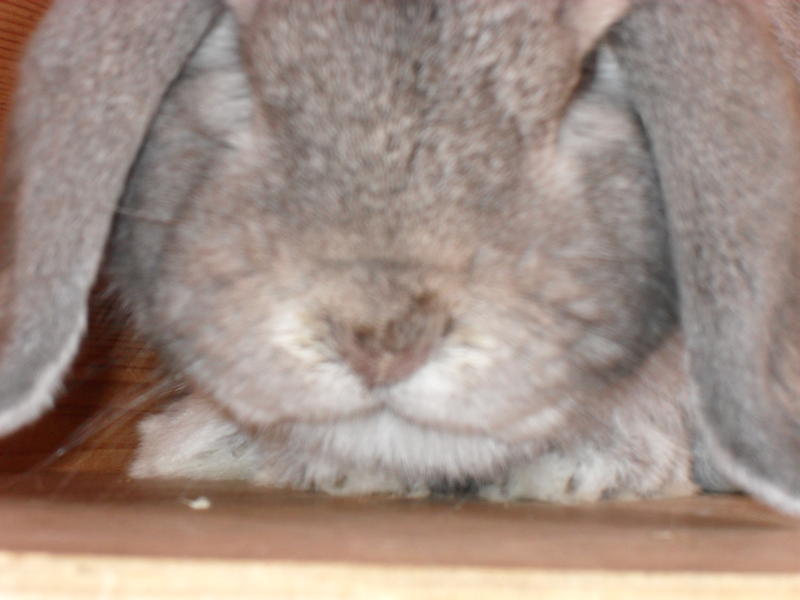| Back to Back Issues Page |
 |
|
Rabbit Rhythm E-zine #019 - Wet bunny noses, the HRS, and more... August 24, 2011 |
Rabbit Rhythms of SeptemberWaning SummerSeptember means summer is waning. As the hours of sunlight dwindle, the rabbits’ rhythms begin to wind down into rest and rebuilding. All hostilities between bucks get put aside for a couple months. Everyone is willing for a while to cohabitate peacefully. This fluctuation in rhythm is essential in a wild warren, where rabbits must be on guard for their lives 24/7. In a domestic rabbitry, however, where cage wire calms nerves and rabbits are not constantly nose to the air currents for their very survival, life can easily go on. When you’re a rabbit breeder, that is easier said than done, since rabbits are hot-wired within the depths of their genetic code to cease breeding for a brief period.
If your livelihood or your dinner table is tied to rabbit production, you can safely ‘fool’ the natural rhythms of your rabbit herd with the same prescription. Fill the rabbit barn with light to simulate a long summer day. With 14 - 16 hours of light each day, the rabbits may very well resume interest in breeding and bearing. Then again, the rest of us rabbit breeders may simply resort to going with the flow for a month or two. (Pictured above: a delightful 4-H exhibitor at the Clallam County (WA) Fair, with her fawn Holland Lop. Shown with permission.)
Healthy RabbitsThere’s one booger-of-a-symptom that tends to plague some rabbits, and that’s a very wet bunny nose, with or without white snot or sneezing. Is it a cold? Allergies? Not likely - allergies have never been scientifically demonstrated in rabbits, that we know of, and the rabbit experts are on record stating that rabbits don’t get temporary (viral) ‘colds’ (Rabbit Production, 6th Ed., pg. 213).
A few months ago, Angie in the UK wrote to us asking these same questions and requesting clarification of info she found on Raising-Rabbits (links below). She is a show breeder of lop rabbits, had acquired some new breeding stock, and two of the new bucks soon developed damp noses. She intended to follow our protocols, and sent us this picture. Whoa. That is definitely a damp nose, and it is accompanied with dampness on the forepaw where the rabbit had wiped his nose clean. In ARBA shows (USA), this would be a disqualification from the show table due to illness.
In the vast majority of rabbits, symptoms like these are chronic and unmitigated, with an occasional brief lull during times of stronger immunity. We suspect the rabbit is infected at least with Bordetella bronchiseptica and possibly also with Pasteurella multocida. That said, you know that we're not vets, and we're separated from said rabbit by a big ocean, so our 'diagnosis' is opinion only. But we do speak from extensive experience and can promise you this -- that wet nose is not normal, and it is very contagious. If you have rabbits with wet noses, sneezing or not, a livestock-rabbit-savvy veterinarian can help you with a proper diagnosis by doing a nasal swab culture and sensitivity. Nevertheless, a culture and sensitivity test does not always give a foolproof diagnosis. Pasteurella is sometimes difficult to culture, as it tends to die if the conditions are not perfect. Administration of antibiotics frequently brings about an improvement in symptoms, which immediately crop back up once the antibiotics are finished. Bordetella responds better than Pasteurella does. However like pasteurella, bordetella tends to remain latent in the rabbit, never eliminated entirely. One of its effects is to damage the lung cilia, the cleaning mechanism of the airways. This apparently is what opens the door to the secondary, and deadly, pasteurellosis. Angie has been lucky. Her buck’s immune system has been strong enough to at least keep him stable...for now. Fortunately for her and her other rabbits: she isn’t fooling herself. She has kept him in quarantine. One day she knows he’ll take a down-turn, and will require euthanization. Learn more: Rabbits in the NewsSince our last e-newsletter, the House Rabbit Society (HRS) has been up to their usual shenanigans. Following an anonymous tip (for which they rewarded the tipster $2,000), and accompanied by their friends at the Foothills Animal Shelter (Denver, CO) and the strong arm of the Jefferson County Sheriffs in Arvada, Colorado, they raided Six Bells Farm, confiscating the entire herd of 200 rabbits from Ms. Debe Bell, the owner. The public outcry was more than the HRS expected. Ms. Bell secured a couple attorneys. Her friends set up a legal trust fund whereby folks could donate $$$ to help pay for the lawyers. Bob McCarty on BigGovernment.com interviewed Ms. Bell. Peter Boyle (Talk Radio 630 KHOW) interviewed her. Click here to listen to that interview. It became very clear that multiple laws and constitutional rights had been violated in the HRS’s rush to ruin yet another rabbit breeder. By August 17, 2011, nearly a month had passed since the raid. The Jefferson County Sheriff was feeling the heat. He released 11 incriminating photos from the raid, out of over 200 taken, in order that the public could become Ms. Bell's judge, jury, and executioner before the case ever went to court. Gotta say, it nearly worked. Two or three photos were fairly shocking, especially when viewed in a vacuum. In a couple pictures, a cage has an ugly pile of poo in a corner of the cage. A couple others picture horribly matted angora rabbits. The public is not going to know that these animals were dropped off with Ms. Bell in order that she would take them to feed predators at the zoo. We do think that the 4-H troop that cleans for Ms. Bell every week may need more supervision, but there was absolutely no need to remove all 200 rabbits. In our opinion, the fact that the stated goal of the HRS is to eliminate rabbit breeders, the fact that there was no initial warrant, and the fact that the Sheriff refused to allow Ms. Bell to explain anything, is ample evidence that Ms. Bell has a strong legal case against her accusers, the House Rabbit Society. She goes to court in mid-September 2011 to face 25 counts of misdemeanor animal cruelty. More info at Animal Cruelty Cases (We sure hate to give airtime to this kind of craziness. But the truth of the matter is: the public needs to know.
What is the official term for
|
| Back to Back Issues Page |
 You’ve heard of Seasonal Affective Disorder (SAD), where people get depressed during fall as daylight hours decrease and sunlight levels are cloudy? The prescription for this is -- more light, of course.
You’ve heard of Seasonal Affective Disorder (SAD), where people get depressed during fall as daylight hours decrease and sunlight levels are cloudy? The prescription for this is -- more light, of course.
 A damp nose such as that pictured, with or without sneezing, is most likely due to something more sinister: bordetella, pasteurellosis, or both.
A damp nose such as that pictured, with or without sneezing, is most likely due to something more sinister: bordetella, pasteurellosis, or both.
 After more than half a year, we heard again from Angie. The same buck is unchanged in condition (newly pictured at right). It is not sneezing. Angie has used him carefully with a few of her does. His days are numbered.
After more than half a year, we heard again from Angie. The same buck is unchanged in condition (newly pictured at right). It is not sneezing. Angie has used him carefully with a few of her does. His days are numbered.
 Why, it’s lappin, of course!
Why, it’s lappin, of course!